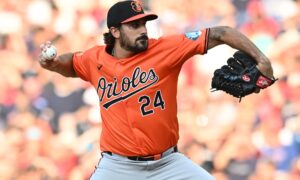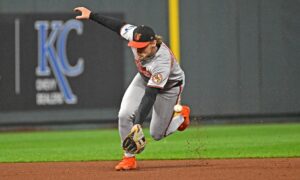SCROLL DOWN TO READ ARTICLE
The idea of Miguel Castro starting baseball games has been kicked around for a while in the Orioles organization.
He made one start at the end of last season – it didn’t go swimmingly (three runs, 3 1/3 innings) — and was used as a starter in his injury-shortened spring before the open rotation spots were filled by Andrew Cashner, Chris Tillman and Alex Cobb.
But with Tillman on the disabled list with a lower back injury and an inflated ERA, a spot has opened, and Castro was scheduled to get the ball to start Wednesday afternoon’s game against the Philadelphia Phillies – but now Cashner will pick up that assignment after Tuesday’s night game was postponed.
We’re not sure when Castro will get another opportunity, or how long that audition may last. One start, a few, the rest of the season?
CONTINUE READING BELOW
In what has suddenly become Twilight Zone worthy, the beleaguered Orioles’ rotation could have too many suitable starters and not enough spots: Dylan Bundy, Kevin Gausman, Cashner and Cobb have done enough – despite some inconsistencies – to get the ball every fifth day.
And rookie David Hess deserves another chance to show that his quality start on Saturday was not an aberration.
Then there’s Castro, who is only 23. That’s younger than Bundy, younger than Hess, even two weeks younger than Orioles’ top pitching prospect Hunter Harvey.
Castro made his big league debut at age 20 and 142 days back in 2015 as a reliever for the Toronto Blue Jays. He was handed the closer’s job, and it didn’t work out. He was traded that year to the Colorado Rockies as part of the deadline deal that sent shortstop Troy Tulowitzki to Toronto.
Castro struggled with the Rockies – he’s not the first to have a Coors Field affliction – and the Orioles acquired him in April 2017 for future considerations (eventually minor leaguer Jon Keller).
CONTINUE READING BELOW
Castro ultimately became a fixture in the Orioles’ bullpen last year, posting a 3.53 ERA in 39 games (one start) and 66 1/3 innings. He’s been nearly as effective this year, a 3.55 ERA in 15 games, though his walks and hits per innings pitched (WHIP) has jumped from 1.22 to 1.34.
The time seems perfect to put Castro into the rotation, at least temporarily, to see what he can do. He’s coming off a relief performance Thursday in which he threw 65 pitches in 4 2/3 scoreless innings. That’s about as long as a reliever will go these days, so he was effectively “stretched out” and on proper rest for Wednesday.
There’s a spot begging to be filled and the Orioles’ season is effectively ripe for experimenting and evaluating.
And, as solid as Castro has been as a multi-inning reliever for the Orioles, there’s no question that starters are more valuable than relievers. So, his opportunity to dance should be given some legs.
That said, there are skeptics.
I recently was talking to a scout who said he thought the acquisition of Castro was one of the shrewdest moves in the Dan Duquette Era.
“I love Miguel Castro, the way he pitches, the presentation, the stuff,” the scout told me.
“Think his future is as a starter?” I asked.
“Nope,” the scout responded quickly. “Listen, it’s a worth a try, but he’s effective as a reliever and he doesn’t seem to be equipped to pitch every fifth day.”
The scout made a couple points.
One, Castro has been primarily a two-pitch pitcher his career: fastball and slider, though his use of his changeup has increased dramatically in 2018 (from 11 percent to 19 percent, while his fastball usage has dropped from 61.5 percent to 52.5 percent, according to Fangraphs).
CONTINUE READING BELOW
The scout believes Castro’s stuff is much more effective facing a lineup once opposed to multiple times.
The second part is the scout wonders whether Castro’s lanky body – he’s listed as 6-foot-7, 205 pounds – and moving-parts delivery will be able to stand up to 180 innings or so during the course of a regular season in a rotation. Indeed, Castro’s body seemed to balk at the beginning of spring training, when he was beginning preparation to be a starter.
My thought here is that it’s worth a try to see how Castro fares, given the aforementioned value associated with rotation members. If it doesn’t stick, the Orioles can return him to the pen, no harm or foul. Plus, pitchers get hurt no matter what role they are in, that’s just the nature of the beast.
So, this is the right time for Castro to dabble in starting. Time and Castro will let us know whether it’s the right call.
17 Comments
You must be logged in to post a comment Login or Register Here
Leave a Reply
You must be logged in to post a comment.










